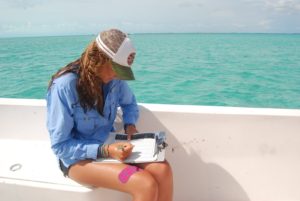Having grown up in San Francisco, I was exposed to the endless nature that Northern California has to offer. I spent my childhood exploring the waters of Baker Beach, surfing the Northern California coastline and hiking and camping in the beautiful mountains of Desolation Wilderness. Waking up early for school every morning was made more enjoyable by the sound of the foghorn—which I have come to love—and the faint smell of the ocean. My interest in nature and the ocean was ingrained in me from a very young age, and was further developed into a passion through the exposure and experience I gained in my coursework at The Branson School. Each morning, as I crossed the Golden Gate Bridge on my way to school, I took in my surroundings—the fog hugged the tall pillars of the bridge and the rugged cliffs dropped steeply into the churning waters of the vast Pacific Ocean. I watched whales and dolphins splashing in the water from my car window. Questions started to pop up in my head. What caused the fog to concentrate in the bay and then disperse almost immediately upon entering Marin? Why were the whales more active during certain months of the year? How did this whole ecosystem work? My interest was sparked and my curiosity craved answers.

Ali Boutros, former LiMPETS Student and GFA intern recording data in the field
Having two older siblings who went to Branson, I knew of a helpful resource who could help answer these questions. Kathy Soave, the chemistry and marine biology teacher at Branson, became my mentor soon after I started my freshman year. Ms. Soave urged me to join a club she led on campus called Sustainable Seas. Excited, and eager to expand my knowledge, I joined Sustainable Seas without hesitation. Once a month, during the low tide, we monitored Duxbury Reef, located in Bolinas, CA. Using quadrats, we counted and tracked the invertebrate and alga species living on the reef, and recorded the data, tracking the ecosystem over an extended period of time. Making the trek out to Duxbury Reef was always so exciting for me. Although in close proximity to the city, it was an escape from hectic city life. It was the first time I was exposed to the coastline north of the Golden Gate Bridge—and I loved it. The ecosystem was extremely diverse; a beautiful lush redwood forest dropped steeply into the cliffs that hugged a marine ecosystem booming with life. During our monitoring we would encounter a myriad of species in the rocky intertidal and could even spot whales splashing on the horizon. I found so many of my close friends through sustainable seas; it was a unique setting that brought like-minded, environmentally centered people together. As young high school students, it was a rare opportunity to actually work in the field. We were exposed to so many new species of invertebrates and algae, and taught how to identify them using marine field guide books. Working in the field at such a young age taught us about the importance of understanding and following scientific procedures and how to analyze the data we collected. The information we gathered was used by LiMPETS (Long Term Monitoring Program & Experiential Training for Students), a citizen science program that monitors the health of sandy beach and rocky intertidal ecosystems. LiMPETS provides these data in a publicly accessible database for scientists. Joining Sustainable Seas further reinforced my passion for marine biology, and I felt it was critical that I take advantage of the advanced environmental science and marine biology classes offered at Branson. As such, I began overloading as soon as I could, taking two science courses at a time during my junior and senior years of high school.
After graduating from Branson, I began university at UCLA where I am currently a senior, pursuing a Bachelor of Science in Marine Biology. I have interned at numerous organizations in an effort to explore my passion for, and expand my knowledge of marine biology. Past internships include: The Marine Mammal Center in Sausalito, CA, the Cape Eleuthera Science Institute, in the Bahamas, a marine biology and environmental science research program at The University of Queensland, Australia, and the Greater Farallones Association (“GFA”), located in San Francisco, where I am currently interning.
I have collaborated and contributed to a myriad of projects here at GFA, but I feel particularly passionate about the LiMPETS mission, its purpose and the role it has in the lives of students like myself. Having previously contributed to fieldwork tasks for LiMPETS, and most recently working with data management for the program, it has been incredibly rewarding to see where the data, which is mostly collected by students, goes, and how it is then used. Given the severity of today’s climate and environmental conditions, it is imperative that we all understand the importance of intertidal zones, but also the repercussions on those affected. The opportunity to participate in this project to a higher degree with GFA has ignited a desire to explore future endeavors in this field.

































